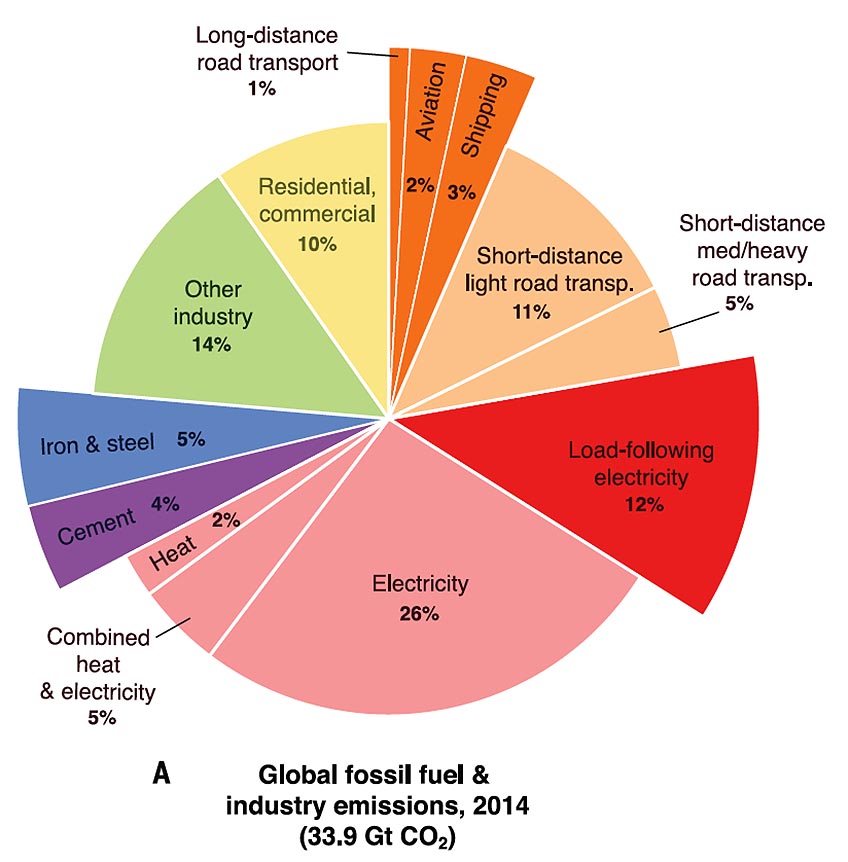Envisioning Net-Zero Emission Energy Systems
NREL researchers contribute to a major journal article describing pathways to net-zero emissions for particularly difficult-to-decarbonize economic sectors
As global energy consumption continues to grow—by some projections, more than doubling by 2100—all sectors of the economy will need to find ways to drastically reduce their carbon dioxide emissions if average global temperatures are to be held under international climate targets. Two NREL authors contributed to a recently published article in Science that examined potential barriers and opportunities to decarbonizing certain energy systems that are essential to modern civilization but remain stubbornly reliant on carbon-emitting processes.
Difficult to Decarbonize Energy Sectors Contribute 27% of Carbon Emissions
Many sectors of the economy, such as light-duty transportation, heating, cooling, and lighting, could be straightforward to decarbonize through electrification and use of low- or net-zero-emitting energy sources. However, some energy uses, such as aviation, long-distance transport and shipping, steel and cement production, and a highly reliable electricity supply, will be more difficult to decarbonize. Together, these sectors contribute 27% of global carbon emissions today. With global demand for many of these sectors growing rapidly, solutions are urgently needed, the article’s authors write.
“The timeframes and economic costs of any energy transition are enormous. Most technologies installed today will have a lifetime of perhaps 30 to 50 years and the transition from research to actual deployment can also be quite lengthy,” said Bri-Mathias Hodge, an author on the paper and manager of the Power Systems Design and Studies Group at NREL. “Because of this we need to be able to identify the most pertinent issues that will need to be solved fairly far in the future and get started now, before we find ourselves heavily invested in even more carbon-intensive, long-term infrastructure.”
Diverse Expert Perspectives Informed Study
Discussion of the article’s underlying issues began at an Aspen Global Change Institute meeting in July 2016. “The diversity and depth of expertise at the workshop—and contributing to the paper—were outstanding,” said Doug Arent, the other NREL researcher to contribute to the paper and deputy associate lab director for Scientific Computing and Energy Analysis. “It was great to hear the different perspectives and learn about new areas that are related to our work at NREL, but that I don’t get to hear about every day at NREL,” added Hodge.
Considering demographic trends, institutional barriers, and economic and technological constraints, the group of researchers concluded that future net-zero emission systems will depend critically on integration of now-discrete energy industries. Although a range of existing low or net zero emitting energy technologies exist for these energy services, they may only be able to fully meet future energy demands through cross-sector coordination. Collaboration could speed research and development of new technologies and coordinating operations across sectors could better utilize capital-intensive assets, create broader markets, and streamline regulations.
Research Should Pursue Technologies and Integration to Decarbonize These Sectors
The article’s authors suggest two broad research thrusts: research in technologies and processes that could decarbonize these energy services, and research in systems integration to provide these energy services in a more reliable and cost-effective way.
The Science article concludes by stating, “if we want to achieve a robust, reliable, affordable, net-zero emissions energy system later this century, we must be researching, developing, demonstrating, and deploying those candidate technologies now.”

Last Updated May 28, 2025
